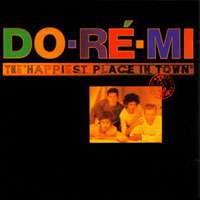The Happiest Place in Town
The Happiest Place in Town is the second LP album by Australian rock/pop group Do-Re-Mi and was released by Virgin Records in August 1988.[2] The album has twelve tracks, which were written by lead vocalist Deborah Conway, drummer Dorland Bray, bass guitarist Helen Carter and guitarist Stephen Philip.[3][4][5][6] Adultery was released as an EP/CD single in 1987, it peaked at #22 on the National singles charts,[7] and also appears on this album. The album and three singles, "King of Moomba", "The Happiest Place in Town" and "Haunt You" had little chart success.[7]
| The Happiest Place in Town | ||||
|---|---|---|---|---|
 | ||||
| Studio album by | ||||
| Released | February 1988 | |||
| Recorded | 1988 | |||
| Genre | Rock, pop | |||
| Label | Virgin | |||
| Producer | Martin Rushent | |||
| Do-Ré-Mi chronology | ||||
| ||||
| Singles from The Happiest Place in Town | ||||
| ||||
| Review scores | |
|---|---|
| Source | Rating |
| Allmusic | |
Background
Do-Ré-Mi had formed in Sydney in 1981 when Deborah Conway (lead vocals) and Dorland Bray (drums, percussion, backing vocals), both previously in Melbourne-based group The Benders, joined Helen Carter (bass, backing vocals) ex-Friction.[4] Stephen Philip (guitar), ex-Thought Criminals, was initially a studio musician for their debut EP, Do-Ré-Mi released in August 1982 and was asked to join formally.[2] They returned to the studio almost immediately and recorded The Waiting Room EP which was released in September 1982.[5][8][9][10] Their debut LP Domestic Harmony was released by Virgin Records in 1985. The Happiest Place in Town was recorded in early 1988 but the album and three singles, "King of Moomba", "The Happiest Place in Town" and "Haunt You" had little chart success.[7] Do-Ré-Mi returned to UK to commence recording their next album. Whilst in UK, Virgin Records offered Conway a solo deal, before continuing with the third album. However Do-Ré-Mi disbanded not long after The Happiest Place in Town was released and the third album was never finished. After the break-up, Conway eventually went solo and had success with her debut album String of Pearls in 1991, its associated single "It's Only the Beginning" peaked at #19;[7] Bray joined Richard Grossman of Hoodoo Gurus and Rob Hirst of Midnight Oil in their side project Ghostwriters for their debut self-titled album; Carter and Philip formed the band Lupi.
Track listing
All tracks were written by Deborah Conway, Dorland Bray, Helen Carter and Stephen Philip, except where indicated.[3]
- "Haunt You"
- "King of Moomba"
- "Adultery" (Bray, Carter, Philip)
- "Valentine's Day"
- "Take Me Anywhere" (Bray, Carter, Philip)
- "Heads Will Roll"
- "Disneyland"
- "Wild and Blue" (Conway, Carter, Philip)
- "Desert Song"
- "Friends Like You" (Bray, Carter, Philip)
- "That Hanging Business" (Bray, Carter, Philip)
- "The Happiest Place in Town" (Philip, Bray)
Personnel
Do-Ré-Mi members
- Dorland Bray — drums, percussion, backing vocals
- Helen Carter — bass guitar, backing vocals
- Deborah Conway — lead vocalist
- Stephen Philip — guitar
Additional musicians
- Alan Dunn — piano accordion
- Johnny Mars — harmonica
- Bob Noble — piano, keyboards, organ (Hammond)
- Frank Ricotti — trumpet
- Steve Sidwell — piccolo trumpet
- John Thirkell — trumpet
- Philip Todd — saxophone (tenor)
Recording details
- Producer — Martin Rushent
References
- Allmusic review
- Nimmervoll, Ed. "Do-Ré-Mi". HowlSpace – The Living History of Our Music (Ed Nimmervoll). Archived from the original on 27 July 2012. Retrieved 10 February 2014.
- "Australasian Performing Right Association". APRA. Retrieved 2008-10-14. Note: requires user to input song title e.g. HAPPIEST PLACE IN TOWN
- Holmgren, Magnus. "Do-Ré-Mi". Australian Rock Database. Passagen.se (Magnus Holmgren). Archived from the original on 5 November 2013. Retrieved 16 March 2014.
- Kruger, Debbie (14–20 July 2004). "Once more with feeling". Melbourne Weekly Bayside Magazine. Retrieved 2008-10-14.
- "Long Way To The Top article on Helen Carter". Australian Broadcasting Corporation. Retrieved 2008-10-14.
- Kent, David (1993). Australian Chart Book 1970–1992. St Ives, N.S.W.: Australian Chart Book. ISBN 0-646-11917-6. NOTE: Used for Australian Singles and Albums charting from 1970 until ARIA created their own charts in mid-1988.
- "Deborah Conway Official Website". Deborah Conway. Retrieved 2008-10-14.
- Harris, Anna (30 January 2004). "Deborah Conway – still alive and brilliant". Archived from the original on 2006-05-14. Retrieved 2008-10-14.
- "Helen Carter video interview for Long Way To The Top". Australian Broadcasting Corporation. Retrieved 2008-10-14.